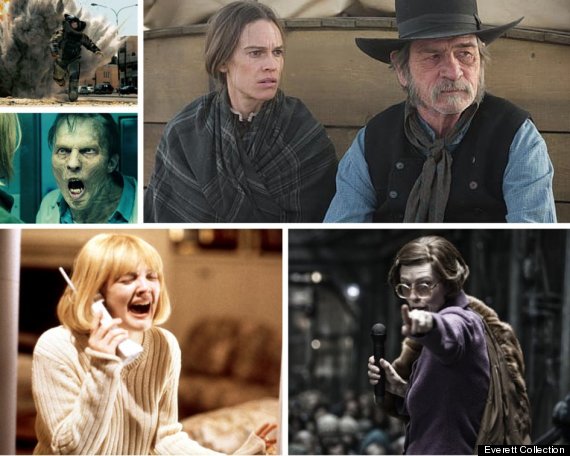
Composer Marco Beltrami has more than 100 credits listed on his IMDb page, from slasher films to blockbusters to meditative dramas to Best Picture winners and almost everything in between. A classically trained musician, he's twice been nominated for an Academy Award. Beltrami excels at empowering music to function on a secondary level that gives the audience insight into the characters emotion; his scores are tight and carefully-controlled, no matter what the genre.
"I think about the palette of the sounds I'm going to use -- orchestral, organic or hybrid. I'm a composer, I listen to it all," Beltrami said. "I think the integrity of the work is more important than the style. Is that vague enough?"
Now 48, the New York-born Beltrami received his big break in 1996, at the age of 30, with his score for Wes Craven's "Scream," a graphic homage to teen-slasher films. Though he's since left his mark on the genre, Beltrami's compelling body of work doesn't allow for typecasting. Besides, he's not even a fan of scary movies. "I hate horror," he said.
His latest composition is far away from co-eds and ghostface masks: Beltrami tackled Tommy Lee Jones' "The Homesman," which highlights the travails of pioneer women, embodied by self-determining Mary Bee Cuddy (Hilary Swank), who welcomes the assistance of a drifter (Jones) to escort a group of three women back east. "It's not necessary that a director has any specific knowledge of music," said Beltrami. "Having said that, I think directing and editing is very rhythmical, a good director is inherently musical. For me to find that in a director makes for a better project."
We caught up with Beltrami at the Middleburg Film Festival, where he was honored as Distinguished Film Composer, to discuss several of his significant contributions to film:
"Scream" (1996)
Beltrami has scored seven films for master of horror Wes Craven, including all four films in the "Scream" franchise.
Beltrami: I really identified with Neve Campbell's character, Sidney Prescott. To have a theme for her was one of the most important things in "Scream." It was the first movie I scored and the first horror movie I ever saw, and I found it terrifying at the time.
"3:10 to Yuma" (2007)
Belrami's first Oscar nomination came for his score in "3:10 to Yuma," a remake of the 1957 classic Western.
Beltrami: I was in bed when they called [about the Oscar nomination]. And, yeah, it was pretty cool. I do think it was one of my better scores. My dream had always been to work on a Western. I think I approach all my movies as if they are Westerns. There were a few sequences that were a lot of fun to write on, but overall I really enjoyed coming up with unique ideas for each character. Ben Wade [played by Russell Crowe] has his own, very simple, three-note theme, plucking these notes inside a piano. I used guitar harmonics for Dan's [Christian Bale] theme. And this manipulated acoustic guitar for Charlie [Ben Foster], Wade and the band of thieves. The different elements interwoven in the score made it really rewarding. I was happy to get the recognition, but I always knew the film was good, and that's why I took it.
"The Hurt Locker" (2008)
Beltrami, with Buck Sanders, earned a second Oscar nomination for "The Hurt Locker," which won six Oscars, including Best Director for Kathryn Bigelow and Best Picture.
Beltrami: Every movie is like a puzzle and cracking this one wasn't easy. The movie plays like a documentary in many ways and so we enhanced the landscape that Kathryn introduced. Though hopefully they work hand in hand, the images and the score, the music shouldn't take you out of the picture. I was often told that you shouldn't be aware of the music when you're watching the movie, but I do I think there's room for both. As we went on, it became more involved. As a viewer you don't notice that -- it's created as a manipulation of real sounds from production, paired with musical sounds and acoustical. The whole conception was different than an ordinary score.
The sniper scene, for me, is when it really comes together. It's a combination of the sounds we were developing and thematic ideas from the picture. You never see such a long sniper scene, and you understand the passage of time and the beauty of it. All of this, helped us to write something that, at this point, really began to blossom.
"World War Z" (2013)
Beltrami composed two scores simultaneously for "World War Z," starring Brad Pitt, in light of conflicts between the filmmaker and the studio.
Beltrami: We had a lot of fun, but it was a tough project. I always thought every day that I would get fired. I ended up writing two scores and recording them simultaneously. It wasn't one voice: The studio had its own vision of the picture and the filmmaker [Marc Forster] had another. There was a big rewrite -- it was too dark for the studio, which wanted a PG, but originally it was more of a hard R -- because the studio wanted a summer popcorn movie. It was meant to be a gritty science fiction-type, horrific story, and I couldn't reconcile the two. They wouldn't talk to each other, and I felt right in the middle. I made the cues the same tempo, so that they could have that battle amongst themselves and that's exactly what they ended up doing. The film is a mix of the two scores.
The zombies communicated by chomping their teeth, and that provided a great percussive score. We got some skulls -- javelina, raccoon ... a lion at one point -- and used them for percussive elements. The studio looked like a taxidermists for a little while.
"Snowpiercer" (2013)
From South Korean director Bong Joon-ho and based on the French graphic novel Le Transperceneige by Jacques Lob, "Snowpiercer" explores life aboard a segregated train, after a failed global-warming experiment exterminates most life on the Earth.
Beltrami: It's the struggle that drives the score. Though it's sort of an allegory, it's the struggle of humanity. For me, I translate that in three elements: the intimate personal story of people like Yona [played by Go Ah-sung] and Curtis [Chris Evan's character], people they loved and lost; the perpetual motion of the train, always moving forward, but never really getting anywhere; the unattainable outside world through the glass. Those three things manifested themselves within my music and, by nature, they became interrelated.
"The Homesman" (2014)
"The Homesman" brings Beltrami and director Tommy Lee Jones together for a third time, previously collaborating on "The Three Burials of Melquiades Estrada" and "The Sunset Limited." "Marco and Buck will go so far as to invent instruments," said Jones, "because of their interest in and pursuit of originality."
Beltrami: Musically, I was discussing with Buck how we might achieve this, exposing this very threadbare existence experienced by these women. With disease and famine and the wind driving them crazy, and they had no amenities, no neighbors, for me to record a score in a rich, acoustically engineered studio seem like the antithesis of that. So we started experimenting with recording outside. We were able to come up with some sounds I'd never heard before. For example, we a massive Aeolian harp out of an upright piano, with the piano strings 200-feet up the hill catching the wind. It became a part of the score -- the wind -- and I'm really happy with so many of the scenes.
There's a scene where Tommy Lee's character gets his money and decides he's going to leave the women and he takes off across the river. And one of the women begins to follow him. At that point, even though they're just crossing the river, it's more than that -- it's like a baptism. It's a story about humanity. It's more than what is shown on the frame; it's the music's job to help the audience feel that.
This interview has been edited and condensed.
